Azay-le-Rideau to Chinon
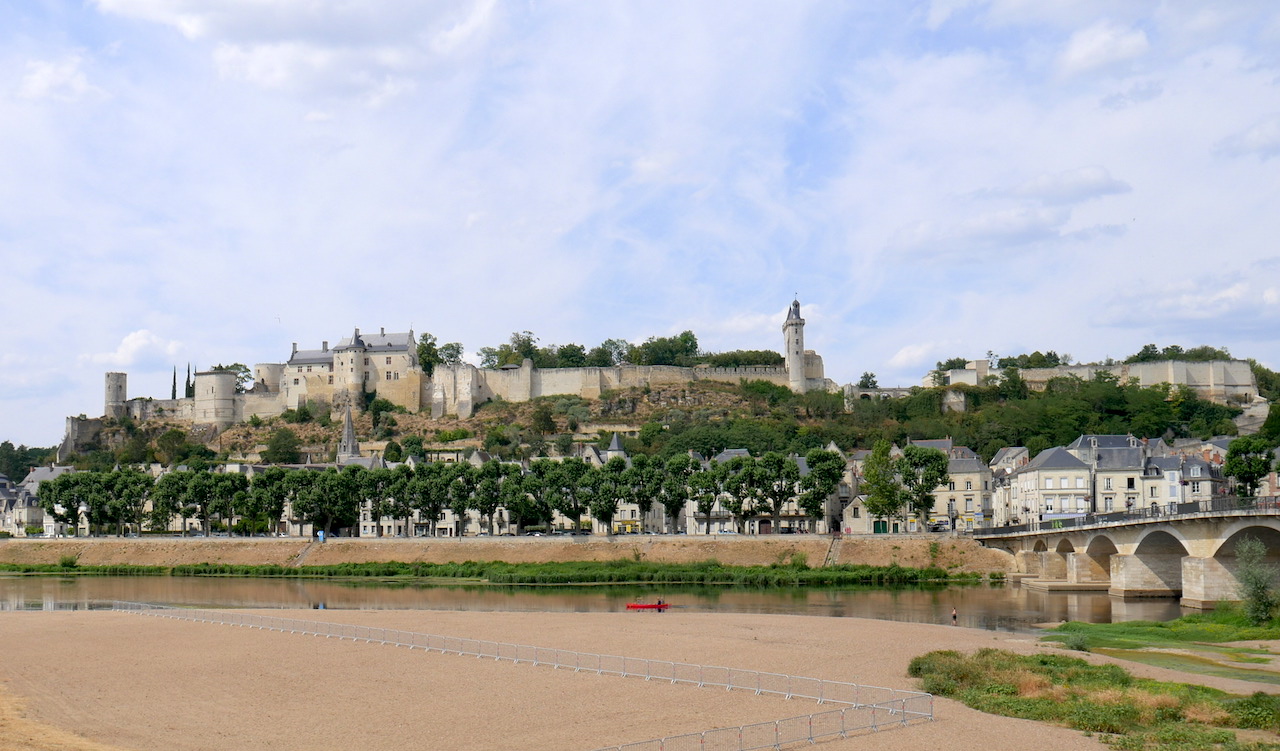
Centre-Val de Loire
10. Azay-le-Rideau to Chinon
Medium
7h
27,5km
+451m
-454m
Step
Embed this item to access it offline
Leaving the castle of Azay-le-Rideau you enter the state-owned forest of Chinon, whose majesty of certain trees still honours its rich past. The layout of the forest roads facilitates your walk, in the summer season you will meet many walkers on foot or by bike. Before Saint-Benoit-la Forêt, on the side of the road, you will observe the old cellars carved out of tuffeau, a fine-grained chalk. After the forest, the Chinon vineyard accompanies you to arrive overlooking the city with ancient troglodyte habitats.
6 points of interest
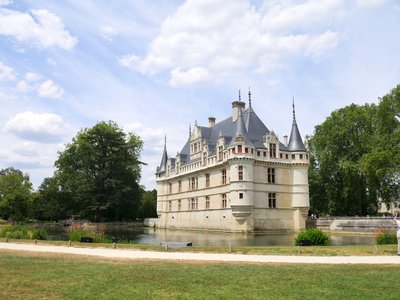
Façade du château d’Azay-le-Rideau - Amis saint Colomban HistoricalAzay-le-Rideau Castle
The first medieval castle of Azay was built around 1119 by one of the first lords of the place, Ridel (or Rideau) d'Azay, cited in a charter of Marmoutier, who built a defensive fortress supposed to protect the road between Tours and Chinon. A Ridel or Rideau d'Azay et de Rillé is mentioned in 1143 and 1153. Lords of Azay appear again from the second half of the 14th century. The fort of Azay is burned by Charles VII in 1418 when the king, staying in Azay on the road to Chinon, is provoked by the Burgundian troops occupying the stronghold.
The present castle was built between 1518 and 1523 by the mayor of Tours and treasurer of King François I, Gilles Berthelot, and his wife, Philippa Lesbahy; it is one of the masterpieces of the early French Renaissance. The foundations, based on pilings and Saint-Aignan stones, were built under the direction of Denis Guillourd.
In 1791, the castle "abandoned and very degraded" is sold by Henry de Courtemanche to the Marquis Charles de Biencourt (1747-1824), Page of the stables of the Queen in 1761, Marshal of the Royal Camps and Armies, deputy of the Nobility at the Estates General of 1789, then to the Constituent. He gave it its present appearance by carrying out profound internal and external changes. His descendants will keep it until 1899. In 1905 the castle was acquired by the State, the whole was classified as a Historical Monument the same day, and a year later was created by decree a "national museum of Renaissance art", placed under the dual responsibility of the curator Xavier de Ricard and the architect Jean Hardion. Since 1907, it has undergone major restorations.
The landscaped park surrounding the castle was laid out in the 19th century.
More info at: Wikipedia
To visit the castle of Azay-le-Rideau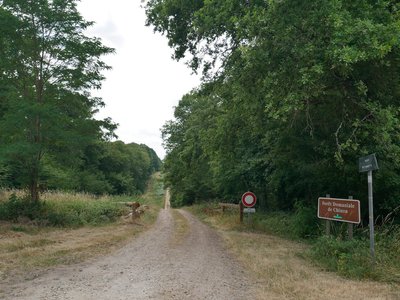
La Via Columbani dans la forêt domaniale de Chinon, carrefour route forestière Charles VII - Amis saint Colomban PanoramicThe national forest of Chinon
Der Staatswald von Chinon stammt aus dem riesigen bewaldeten Massiv, das im Mittelalter die Hochebene von Sainte-Maure-de-Touraine bedeckte. Früher ein Seigneurialbesitz, dann ein königliches Jagdrevier, wurde es während der Revolution in Staatsbesitz. Heute ist es ein wichtiger Holzproduktionsstandort, dessen ökologischer Reichtum anerkannt ist. Die Förster bemühen sich auch, die Erwartungen einer wachsenden Zahl von Besuchern zu erfüllen.
Es stellt ein Relief dar, das von mehreren Tälern (Maupas, Fosse aux loups, Turpenay...) geformt und eingekerbt ist, in denen kleine Bäche fließen. Die Aufschlüsse von Kalkstein-, Ton- und Sandsteinfelsen sind der Ursprung einer großen Vielfalt von Böden und Landschaften.
Die natürlichen Bedingungen sind günstig für die Eiche, die die dominierende Art ist. Der bemerkenswerte ökologische Reichtum des Massivs hat zur Schaffung des vom Maupas-Tal verwalteten biologischen Reservats und zur Klassifizierung von drei Sektoren als Natura-2000-Gebiete geführt. Es gibt viele seltene und geschützte Pflanzen, die in ein Waldgebiet von fast 12.000 ha integriert sind. Der Wald von Chinon ist die Heimat mehrerer Arten von Hochwild (Hirsche, Rehe, Wildschweine ...).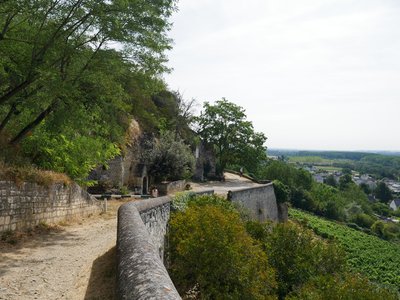
Vignes de Chinon à flanc de coteau de la ville de Chinon - Amis saint Colomban CulturalChinon vineyard
This vineyard is located around the city of Chinon, including both banks of the Vienne River and up to the confluence of the Loire River. There are three types of soil: The first with the alluvial terraces of the left banks of the Loire and Vienne rivers, composed of gravel and sand. The second is on the limestone hillsides and mounds, composed of chalk and tuffeau. The third is on the top of the slopes with flint clays and sands. The terraces of the Loire are very sandy.
The area in production covers approximately 2,300 hectares with a production volume of 110,000 hectolitres. The wines produced are mostly red wines, there are only 13% rosé wines and 2% white wines.
More information: Wikipedia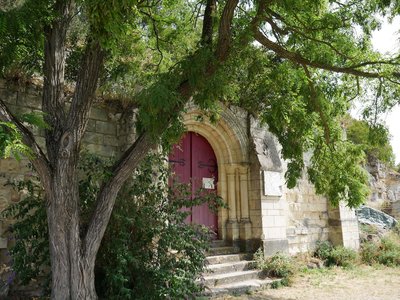
Entrée de la chapelle Sainte-Radegonde à Chinon - Amis saint Colomban TouristSainte-Radegonde Chapel in Chinon
The Chapel is located on Via Columbani, a semi-troglodytic Romanesque chapel built around the tomb of a hermit from the High Middle Ages (6th century). You will discover a well dug in the rock and a mural painting from the end of the 12th century representing the Plantagenets.
Open every afternoon from 3pm to 6pm.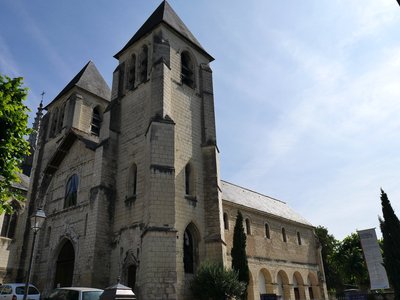
Collégiale Saint-Mexme - Amis saint Colomban TouristSaint-Mexme Collegiate Church in Chinon
Gregory of Tours, in his "De la gloire des confesseurs" (On the glory of the confessors), recounts the installation in the 5th century of Mexme, a disciple of Saint Martin, in a troglodytic hermitage in Chinon, to the east of the Roman castrum which was to become the present castle. Saint Mexme is said to have founded a first church, which served as the centre of a small monastery, transformed into a collegiate church around the year 1000. The church was then rebuilt on a basilical plan, then enlarged in 1050 by the addition of a western massif comprising a narthex framed by two towers. In the 12th century, the nave was extended towards the west, a transept and a choir with an ambulatory and radiating chapels completed the transformation of the collegiate church into a vast pilgrimage building.
After the Revolution, work was necessary to return the building to worship, but in 1817, the collapse of the bell tower at the transept crossing led to the ruin of the eastern parts. The remaining parts, the nave and the western section, were then transformed into a school until 1980. A vast restoration work was then undertaken, accompanied by excavations to learn more about the history of the building. The collegiate church is today an open cultural centre for temporary exhibitions. The Collegiate Church contains mural paintings from the 12th to the 15th centuries.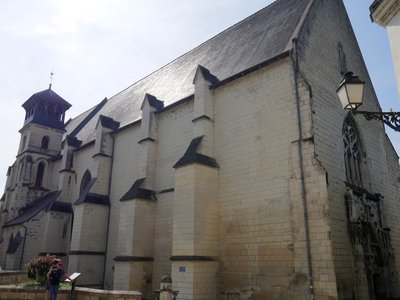
L’église Saint-Étienne de Chinon - Amis saint Colomban TouristSaint-Étienne Church of Chinon
This church was rebuilt between 1460 and 1490 by the architect Pierre Mesnager for Philippe de Commines. It occupies the place of a Romanesque building of which the base of the bell tower is a vestige (11th century). The facade is pierced by a double basket-handle door, surmounted by two hooks and fleurons braces, inscribed on either side of a canopy niche, in a tympanum circumscribed by a large brace falling on two buttresses hollowed out of niches and decorated with pinnacles. In the nave, third-point arcades separate the nave from the chapels. The choir ends with a five-sided apse pierced with flamboyant latticework windows. The stained glass windows are by L.-L. Lobin.
Description
On the square in front of the church of Azay-le-Rideau take left rue Rabelais, second street on the left, cross the river Indre. Second street on the right, chemin des Chamvrils, dirt road on the left in the first bend, on the right rue du Vieux Chêne, after the bridge over the D 751 third tarred street on the left, chemin Beaufou
- Carrefour Baigneux le Haut on the left, Xaintrailles forest road, first path on the right on the edge of the forest, on the left enter the forest, on the right, Isabeau de Bavière forest road.
- Carrefour de la Herpinière take the forest road in front of you, first path on the right, take the forest road to Isabeau de Bavière
- Carrefour Le Bois Bourreau, on the right for a few meters on the left chemin dans le bois, on the right at the crossroads of the forest road of Marie d'Anjou
- Carrefour du Tertre second road on the left, first road on the right, cross the railroad tracks to follow it.
- Right, route de Françoise de Foix, third road on the left
- On the left, Duras forest road, cross the railway, on the right track along the railway, first road on the left, crossroads with D 139 on the right, first street on the right, rue Jaulnay,
- After La Briandière at the crossroads on the right La Maison Rouge, Jacques Molay, after the Maison forestière Jacques Molay straight on chemin dans le bois, crossroads Charles le Téméraire second road on the left, route forestière de Louis XI, second road on the right
- Turn left at the crossroads with rue du Blanc Carroi, cross the roundabout, rue Gustave Eiffel, at the crossroads with rue Le Corbusier second on the left, a dirt road that runs along an industrial site,
- In the vineyard, turn left on the asphalt road and first right at the crow's feet, second road on the right Chemin des Coutières, first road on the left, Pas des Goutières, cross Rue de la Rochefaucon, Rue du Coteau de Sainte-Radegonde, Rue du Pitoche, cross the Place Collégiale Saint-Mexme on the right Rue Jean-Jacques Rousseau, you will arrive at the Saint-Etienne church.
- Departure : Saint-Symphorien Church, Place du 11 Novembre 1918, 37190 Azay-le-Rideau
- Arrival : Saint-Étienne Church, Place de l'Église Saint-Étienne, 37500 Chinon
- Towns crossed : Centre-Val de Loire
Altimetric profile
Transport
Report a problem or an error
If you have found an error on this page or if you have noticed any problems during your hike, please report them to us here:









